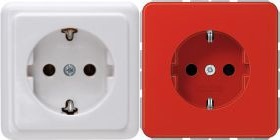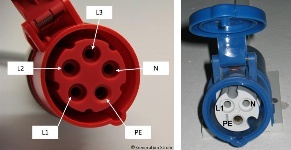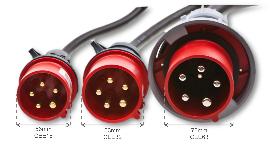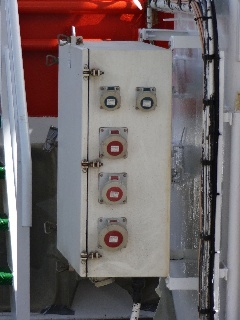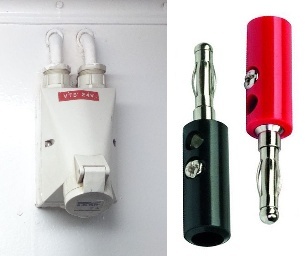Stromversorgung
Die Stromversorgung ist in mehrere Netze aufgeteilt. Je nach Anforderung stehen saubere Netze für elektronische Geräte und Umformernetze für elektrische Geräte zur Verfügung. Die nautischen Geräte auf der Brücke werden über ein separates Nautik-Netz betrieben.
Alle Funktionsräume, Labore und Kammern sind mit rot gekennzeichneten 220-V-Steckdosen (Euronorm) ausgestattet, die vom sauberen Netz gespeist werden und zusätzlich über zwei unterbrechungsfreie Stromversorgungsanlagen (USV) von je 120 KVA elektrischer Leistung gepuffert sind. Dieses Netz ist spannungs- und frequenzstabilisiert < +/- 1% (AC 220 V, 50 Hz).
Die Standorte für Container sind mit CEE-Steckdosen für 220 V (16A-6h, 2P+PE) und 380 V (16A, 32A und 63A-6h, 3P+N+PE) ausgestattet.
Die gesamte Stromversorgung basiert auf einer Frequenz von 50 Hz und einer Gesamtleistung von 4400 KW, wobei für die sauberen Netze 390 KW zur Verfügung stehen.
Die Erzeugung elektrischer Energie erfolgt im Seebetrieb grundsätzlich über zwei Wellengeneratoren, sonst über zwei Hilfsdieselaggregate.
Das Schiff verfügt über unterschiedliche elektrische Netze:
660 Volt, 50 Hz
380/220 Volt, 50 Hz
380/220 Volt, 50 Hz über Umformer für Labore und nautische Verbraucher
24 Volt, Gleichstrom
Verbraucher mit einem hohen Leistungsbedarf werden aus dem 660-Volt-Netz gespeist. Die anderen Verbraucher, insbesondere die aus dem Maschinenbereich, sind an das 380-Volt-Netz angeschlossen. Alle Kammern, Labore und wissenschaftlichen Räume sind mit 220-Volt-Steckdosen ausgerüstet.
Rechner und empfindliche wissenschaftliche Geräte können über besonders gekennzeichnete Steckdosen (rot) an das geschützte Netz (K-Netz) angeschlossen werden. Über 2 USV-Anlagen wird eine ungestörte und gepufferte Stromversorgung sichergestellt.
Alle sicherheitsrelevanten Verbraucher werden im Havariefall über die Notschalttafel durch einen Notgenerator versorgt.
Das Schiff besitzt einen Landanschluss für 1000 A für das normale Netz und 100 A für das Sondernetz.
Hauptschalttafel (Foto:M.Hirsekorn)
